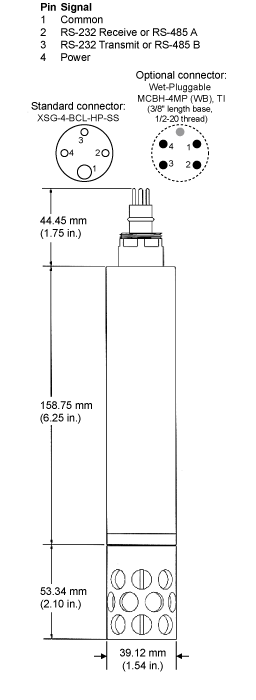 Digital Oceanographic Thermometer
Digital Oceanographic Thermometer SBE 38
 Digital Oceanographic Thermometer
Digital Oceanographic Thermometer ![]()
![]() Print version
Current manual (older
manuals)
Reference Sheet
Configuration options & accessories
Print version
Current manual (older
manuals)
Reference Sheet
Configuration options & accessories

Sophisticated A/D acquisition electronics, ultra-stable thermistor, and state-of-the-art calibration provide the standards-level performance of an expensive AC bridge and platinum thermometer at a small fraction of the cost. The SBE 38 is unaffected by shock and vibration, has high accuracy and stability, and is easy to use. It has a rugged, corrosion-proof, 10,500 meter (34,400 ft) titanium pressure housing. Real-time temperature data is transmitted in ASCII characters (°C or raw counts) via an RS-232 or optional RS-485 serial interface for display or logging by PC or data logger.
The SBE 38's measurement range is -5 to +35 °C; absolute accuracy is better than 0.001 °C (1 mK) and resolution is approximately 0.00025 °C (0.25 mK). Each sensor includes certification that demonstrates drift of less than 0.001 °C during a six-month period.
Applications include calibration baths, oceanographic/aquatic research, and environmental monitoring. The SBE 38 is frequently integrated as a remote temperature sensor with an SBE 21 Thermosalinograph or SBE 45 MicroTSG, to provide accurate sea surface temperature. It can also be integrated as a secondary temperature sensor with an SBE 16plus, 16plus-IM, 16plus V2, 16plus-IM V2, or 19plus V2 SeaCAT CTD.
OPERATIONThe SBE 38 operates in one of three modes:
On power up, the SBE 38 reads its EEPROM, which includes calibration coefficients and other setup information. As programmed, the SBE 38 samples and transmits temperature continuously, or waits for a command. For RS-485 with several sensors sharing one pair of wires, the SBE 38 cannot sample continuously.
MEASUREMENT METHOD
Temperature is determined by applying an AC excitation to reference resistances and an ultra-stable aged thermistor with a drift rate of less than 0.002 °C per year. Each of the resulting outputs is digitized by a 24-bit A/D converter. The reference resistor is a hermetically sealed VISHAY. AC excitation and ratiometric comparison using a common processing channel removes measurement errors due to parasitic thermocouples, offset voltages, leakage currents, and gain errors. The maximum power dissipated in the thermistor is 0.5 microwatts, and contributes less than 200 µK of overheat error.
A raw count (ratio) is related to resistance measurements:
raw counts = 1048576 * NT / NR
where: NR is the output from the reference resistor and NT is the thermistor output.
The number of acquisition cycles (raw counts) averaged per sample is user-programmable. Increasing the number of cycles per sample increases the time to acquire the sample and the interval between samples, while reducing the RMS temperature noise from the sensor. The interval between samples is:
interval [seconds] = (0.133 * Navg) + 0.339
where: Navg is the number of acquisition cycles per sample.
The SBE 38’s converted output is computed from the raw count and the calibration coefficients that are stored in EEPROM.
CALIBRATION
The SBE 38 is calibrated in Sea-Bird's state-of-the-art calibration laboratory, which maintains primary temperature standards (water triple point [TPW] and gallium melting point [GaMP] cells), ITS-90 certified and standards-grade platinum resistance thermometers, and a low-gradient temperature bath.
Temperature is computed using the Steinhart-Hart polynomial for thermistors (Steinhart and Hart, 1968; Bennett, 1972), which is based on thermistor physics. The equation characterizes the non-linear temperature versus resistance response of the sensor. Note that thermistors require individualized coefficients to the Steinhart-Hart equation, because the thermistor material is an individualized mix of dopants:
t 90L = { [ 1.0 / (a0 + a1*ln(n) + a2*ln²(n) + a3*ln³(n) ) ] - 273.15} * Slope + Offset [°C]
where: n is the SBE 38 output.
SPECIFICATIONS
Interface and Power Requirements:
Housing: Titanium, rated at 10,500 meters (34,400 feet)
Weight:
Range: -5 to +35 °C
Initial Accuracy 1: ± 0.001 °C (1 mK)
Resolution: 0.00025 °C (0.25 mK)
Stability: 0.001 °C (1 mK) in six months, certified
Response Time 2: 500 milliseconds
Self-heating Error: less than 200 µK
1NIST-traceable calibration applying over the
entire range.
2Time to reach 63% of final value following a step change in
temperature.
|
Actual Calibration Data for Sensor Number 80 |
|||
| Bath Temperature (°C) |
Instrument Output (n) |
Instrument Temperature (°C) |
Residual (Instrument - Bath) (°C) |
| -1.52985 | 824162.7 | -1.52983 | 0.00002 |
| 1.03108 | 733633.1 | 1.03106 | -0.00002 |
| 4.60520 | 625547.1 | 4.60518 | -0.00002 |
| 8.11169 | 536776.4 | 8.11169 | -0.00000 |
| 11.61533 | 462132.6 | 11.61536 | 0.00003 |
| 15.17575 | 398167.3 | 15.17574 | -0.00001 |
| 18.63931 | 345476.6 | 18.63934 | 0.00003 |
| 22.14032 | 300170.8 | 22.14031 | -0.00001 |
| 25.66793 | 261276.6 | 25.66793 | 0.00000 |
| 29.13948 | 228549.1 | 29.13944 | -0.00004 |
| 32.61481 | 200420.3 | 32.61484 | 0.00003 |
Click on thumbnail to view sample calibration graph.
ADDITIONAL INFORMATION / LINKS:
Documentation -- manual, photos, technical papers, application notes, etc.
Sales Information -- options, accessories, cables, mount kits, spares, etc.
Software -- components of Seasoft V2
Links to Other Instruments of Interest
![]()
Specifications are subject to change without notice.
Sea-Bird Home Phone: (+1) 425-643-9866 E-mail: seabird@seabird.com